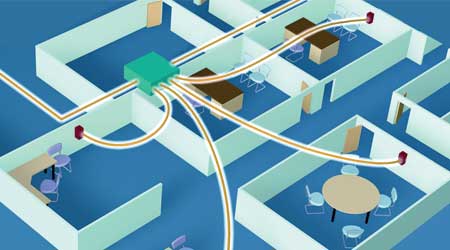« Back to Facilities Management Building Automation Category Home
Aircuity: IoT can give building occupants healthier, safer more comfortable indoor environments
November 20, 2015
- Building Automation

Question: What are the benefits of the IoT for building occupants today?
Answer: IoT means that building occupants benefit from healthier, safer more comfortable indoor environments with less reliance on facility services. Connected systems means a more responsive environment and spaces can be customized for use and occupancy- no more one-size-fits-all all-the-time. Intelligent systems automate and expedite repetitive tasks, freeing up human resources to do higher-value tasks.
Demand control ventilation is one of the results of IoT that can provide significant impact for occupants. For example, on Monday morning a conference room hosts 3 people meeting for an hour, in the afternoon it hosts 30 people for a half-day workshop. With real-time sensing and response, the room not only maintains a comfortable temperature so the morning meeting doesn’t freeze while the afternoon swelters, it also supplies enough fresh air to keep the afternoon attendees awake. Sensors coupled with data aggregators and cloud-based analytical software generates real-time trends of space parameters and summaries of energy, indoor environmental quality and greenhouse gases automatically, no spreadsheets required.
Question: What advantages does IoT technology provide for facility professionals today?
Answer: Facility professionals benefit from less risk, fewer headaches and more savings. Intelligent systems enable dynamic control, at all times and in all conditions. Smarter systems mean fewer support calls and emerging problems are identified and resolved before they impact the occupants. Additionally, on demand and autonomous operation with proactive maintenance means less wear-and-tear on equipment, less downtime, and fewer operational resources needed. And all of that means more savings.
In order to meet energy and greenhouse gas reduction goals, many facility owners have reduced the number of air changes per hour (ACH) in critical spaces like laboratories to an average set-point considered “safe"; employing a set-it and forget-it strategy. Using an average ACH means that when the space isn't over-ventilated, it’s under-ventilated. Owners can achieve the same or better reductions while ensuring safety at all times by employing dynamic controls that respond to the specific conditions of each space in real-time. Predictive analytics fed by sensors in the various components of the a centralized demand control ventilation system can determine performance degradation and trigger replacement parts to be sent and service scheduled with little to no human interaction.
Source: JoAnn Garbin, Vice President, Product Management for Aircuity.
For more insights on the products, technology, benefits and challenges of the Building Internet of Things, visit www.FacilitiesNet.com/IoT








